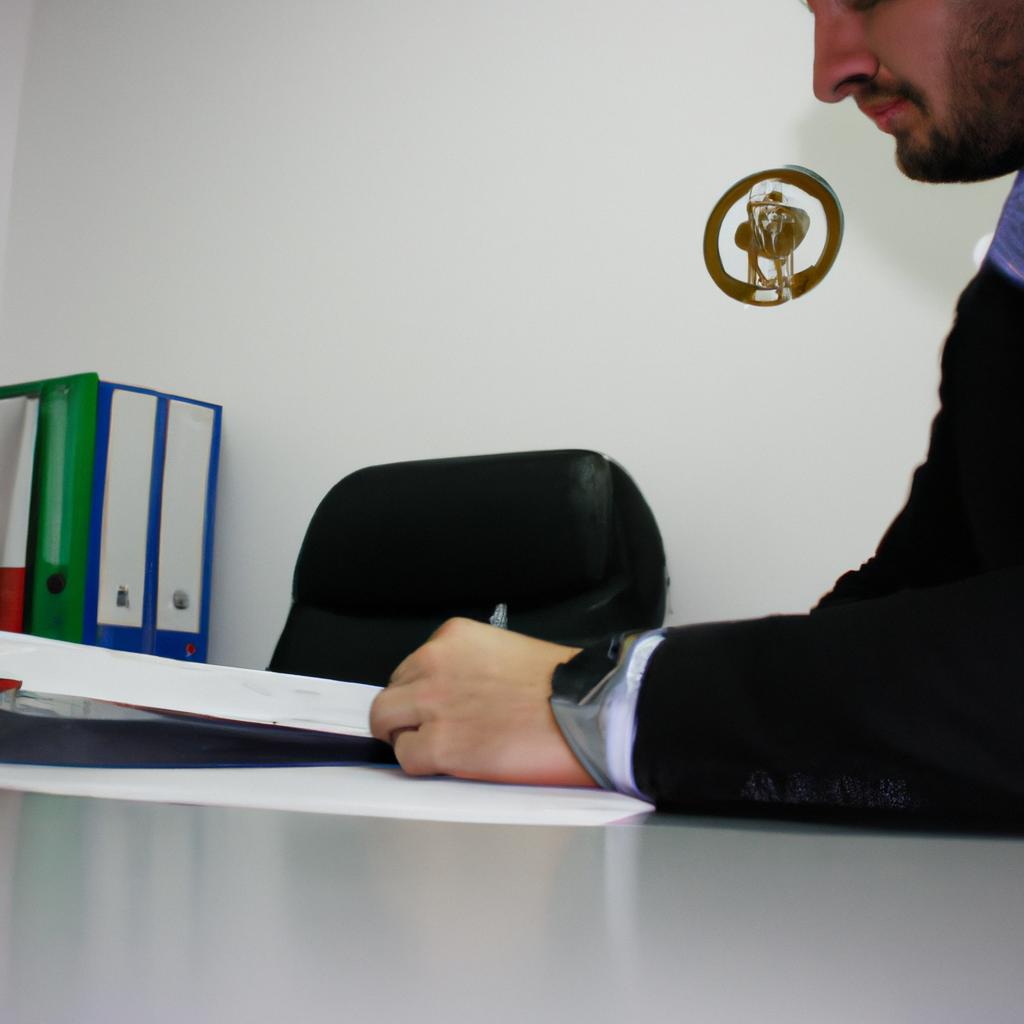In the fast-paced world of litigation, effective trial preparation is crucial for maximizing success in a law firm. This article explores the importance of leveraging litigation assistance to enhance trial readiness and improve overall outcomes. By utilizing comprehensive strategies and resources, law firms can ensure they are fully prepared to navigate complex legal proceedings.
One example that highlights the significance of trial preparation involves a hypothetical case involving a multinational corporation facing allegations of environmental misconduct. In this scenario, meticulous trial preparation becomes essential, as it requires extensive research into relevant laws and regulations, gathering evidence from various sources, and developing persuasive arguments to counter opposing counsel’s claims. Through strategic collaboration with litigation assistants, attorneys can streamline their workload by delegating tasks such as document management, witness coordination, and courtroom technology support. This allows lawyers to focus on crafting compelling narratives and effectively representing their clients’ interests during trial proceedings.
By incorporating rigorous trial preparation methodologies into their practices, law firms can optimize efficiency while minimizing risks associated with inadequate planning or oversight. The subsequent paragraphs will explore key aspects of trial preparation that maximize litigation assistance within law firms, including thorough case analysis, skilled paralegal support, and advanced technological tools.
Understanding the Trial Process
The process of preparing for a trial in a law firm can be complex and demanding, requiring careful attention to detail and strategic planning. By understanding the various stages involved in a trial, legal professionals can effectively navigate through this intricate process. To illustrate, consider the following hypothetical scenario: A law firm is representing an individual who was injured in a car accident caused by another driver’s negligence. The goal of the trial preparation is to prove that the defendant should be held liable for their client’s injuries.
During the pre-trial stage, attorneys gather evidence, interview witnesses, and conduct research to build a strong case. This includes obtaining police reports, medical records, and any other relevant documentation that supports their client’s claim. In addition, they may consult with experts such as accident reconstruction specialists or medical professionals to strengthen their arguments.
Once all necessary information has been collected, it is time to move on to the next phase—trial strategy development. Here, lawyers carefully analyze the evidence at hand and devise a comprehensive plan aimed at presenting the most compelling argument possible. They must anticipate potential challenges from opposing counsel and strategize how best to counter them.
As trial approaches, thorough preparation becomes crucial. Attorneys meticulously organize their case materials and rehearse presentations in order to present information clearly and persuasively before a judge or jury. Every detail counts—from crafting opening statements that capture attention to formulating closing arguments that leave a lasting impact.
To emphasize the importance of effective litigation assistance throughout this challenging process, here are four key considerations:
- Clear communication between attorneys and support staff ensures seamless coordination during trial preparation.
- Timely responses from expert witnesses contribute significantly to building a solid case foundation.
- Diligent document management streamlines access to critical evidence when needed.
- Proactive collaboration among team members fosters efficiency and maximizes productivity.
Furthermore, visual aids such as tables can enhance jurors’ understanding of complex data or timelines. For instance, a table could be used to present medical records chronologically, highlighting the progression of injuries and treatment received.
In summary, understanding the trial process is crucial for law firms seeking to maximize litigation assistance. From pre-trial preparations to strategy development and thorough case organization, legal professionals must navigate each stage meticulously. By following these guidelines and effectively utilizing visual aids like tables, attorneys can ensure a strong foundation upon which they can build their arguments. The next section will delve into the importance of identifying key witnesses in trial preparation.
Identifying Key Witnesses
Having gained an understanding of the trial process, it is crucial for law firms to maximize their litigation assistance capabilities. By implementing efficient strategies and utilizing available resources effectively, legal teams can enhance their preparation efforts and increase their chances of success. Let us explore some key approaches that can be employed in this regard.
Paragraph 1:
To illustrate the importance of maximizing efficiency in trial preparation, consider a hypothetical case involving a complex corporate dispute. The law firm representing one party must gather extensive evidence, identify potential witnesses, and develop persuasive arguments within a limited timeframe. In such situations, following these guidelines can significantly benefit the litigation process:
- Streamline document management systems to facilitate easy access and retrieval of relevant information.
- Utilize technology tools for case analysis, research, and organization.
- Establish clear communication channels among team members to ensure seamless collaboration.
- Leverage external resources like expert consultants or investigators when necessary.
By adopting these practices, law firms can optimize their trial preparation efforts and improve overall performance.
Paragraph 2 (Bullet Point List):
In order to evoke an emotional response from the audience while highlighting important considerations related to trial preparation, we present below a bullet point list outlining common challenges faced by legal teams:
- High stakes: The outcome of trials often has significant implications on clients’ lives or businesses.
- Time pressure: Limited timeframes require lawyers to work efficiently without compromising thoroughness.
- Complexity: Cases may involve intricate legal issues requiring meticulous attention to detail.
- Emotional impact: Clients may experience stress or anxiety throughout the litigation process.
These factors underscore the need for effective trial preparation techniques discussed in this guide.
Paragraph 3 (Table):
To further emphasize key aspects of maximizing litigation assistance, let us examine a table showcasing different methods commonly employed by law firms:
| Method | Description | Benefits |
|---|---|---|
| Case management | Utilizing software tools to centralize and organize case-related information. | Improved organization, accessibility, and efficiency. |
| Collaborative work | Establishing platforms for seamless communication and collaboration among team members. | Enhanced teamwork and coordination for better outcomes. |
| Technology usage | Leveraging advanced legal technology tools for research, analysis, and document management. | Increased accuracy, speed, and effectiveness. |
| External support | Engaging expert consultants or investigators to complement internal resources as needed. | Access to specialized knowledge and expertise. |
Incorporating these strategies can lead to more effective trial preparation while addressing various challenges encountered during the litigation process.
Transition into the subsequent section about “Gathering Evidence and Documentation”:
With a solid understanding of how to maximize litigation assistance in law firms, the next step involves gathering evidence and documentation that will form the basis of persuasive arguments presented at trial. By meticulously collecting relevant information from various sources, legal teams can build strong cases capable of withstanding scrutiny in courtrooms worldwide.
Gathering Evidence and Documentation
After identifying key witnesses, it is crucial to gather compelling evidence and documentation to strengthen your case. By presenting a strong evidentiary foundation, attorneys can effectively support their arguments during trial proceedings. Let us explore some essential steps involved in this critical phase of trial preparation.
Gathering Evidence and Documentation:
To illustrate the significance of gathering evidence and documentation, consider the following hypothetical scenario: A plaintiff brings forth a medical malpractice lawsuit against a hospital for negligence resulting in severe harm. In order to prove their case, the attorney must collect various types of evidence such as medical records, expert witness opinions, witness statements, and any other relevant documents or physical artifacts that substantiate the claim.
During this phase of trial preparation, several strategies can maximize litigation assistance within a law firm setting. Here are four key practices that ensure effective evidence collection:
- Conducting thorough research on applicable laws and regulations.
- Employing experienced investigators trained in gathering evidence.
- Utilizing technology tools for efficient data management and analysis.
- Collaborating with experts across different fields to authenticate specialized findings.
Furthermore, organizing the collected evidence into a coherent structure enables attorneys to present their arguments more convincingly during trial proceedings. The table below outlines an example organization methodology for tracking and categorizing gathered evidence:
| Category | Description | Relevance |
|---|---|---|
| Medical Records | Patient’s history, treatments received | Establishes baseline health condition |
| Expert Opinions | Testimonies from medical professionals | Supports claims regarding negligence |
| Witness Statements | Accounts from individuals at the scene | Provides firsthand accounts of events |
| Physical Evidence | Photographs, objects related to the incident | Supports claims through tangible proof |
By following these practices and employing a systematic approach to evidence collection, attorneys can enhance their chances of success in the courtroom. This meticulous preparation ensures that lawyers are equipped with solid evidentiary support when presenting their case during trial.
With the evidence gathered diligently, the subsequent step involves preparing persuasive opening statements. By effectively setting the stage for the trial proceedings, attorneys can capture the attention of the jury from the outset and establish a strong foundation for their arguments.
Preparing Opening Statements
Section Title: Maximizing Efficiency in Trial Preparation
Transitioning from the previous section on gathering evidence and documentation, it is crucial for law firms to implement strategies that maximize efficiency during trial preparation. By adopting effective practices, attorneys can streamline their workflow, allocate resources appropriately, and enhance their overall litigation assistance. To illustrate this point, consider a hypothetical case study involving a personal injury lawsuit against a manufacturing company. The plaintiffs claim to have suffered injuries due to a defective product.
Efficiency in trial preparation begins with thorough organization of evidence and documentation. Attorneys must ensure that all relevant materials are properly categorized and easily accessible. This includes medical records, witness statements, expert reports, photographs, video footage, and any other supporting documents. Maintaining an organized system allows legal teams to quickly locate necessary information during trial without wasting valuable time searching through scattered files or digital folders.
To further optimize trial preparation efforts, it is essential for law firms to prioritize tasks effectively. Consider implementing the following strategies:
- Develop a comprehensive timeline outlining key milestones in the trial process
- Assign clear responsibilities to team members based on their expertise
- Utilize project management software to track progress and deadlines
- Conduct regular meetings to provide updates and address any potential challenges
By adhering to these strategies, attorneys can create a structured environment conducive to efficient collaboration among team members.
In addition to organizing evidence and prioritizing tasks efficiently, law firms should also focus on maintaining strong communication channels both internally within the firm as well as externally with clients and experts involved in the case. Clear lines of communication help avoid misunderstandings or delays in obtaining critical information or feedback. Regularly scheduled check-ins with clients ensure that they are informed about the progress of their case while also allowing them an opportunity to provide additional insights or concerns.
Table Example:
| Key Strategies | Benefits | Examples |
|---|---|---|
| Thorough organization | Quick access to evidence | Categorized files |
| Efficient retrieval of data | Digital folders | |
| Prioritizing tasks | Structured workflow | Comprehensive timeline |
| Improved collaboration | Clear responsibilities | |
| Maintaining | Timely updates for clients | Regular check-ins |
| communication | Enhanced client satisfaction | Open lines of feedback |
In conclusion, maximizing efficiency in trial preparation is paramount to the success of law firms. By organizing evidence and documentation, prioritizing tasks effectively, and maintaining strong communication channels both internally and externally, legal teams can ensure a streamlined approach to litigation assistance. The next section will delve into strategies for crafting effective cross-examinations as part of comprehensive trial preparation efforts.
Crafting Effective Cross-Examinations
Building upon the foundation of well-prepared opening statements, litigators can further enhance their trial preparation by focusing on crafting effective cross-examinations. By skillfully questioning witnesses during this critical phase of a trial, attorneys have the opportunity to challenge opposing parties’ credibility and strengthen their own case. To illustrate the importance of strategic cross-examinations, let us consider a hypothetical scenario involving a personal injury lawsuit.
Paragraph 1:
In our hypothetical case, John Smith has filed a personal injury claim against ABC Manufacturing Company after sustaining injuries from using one of their defective products. During cross-examination, the defense attorney aims to undermine Smith’s credibility and cast doubt on his version of events. The attorney strategically questions Smith about inconsistencies in his testimony, highlighting any prior conflicting statements made outside of court. Through a deliberate line of inquiry, the defense seeks to weaken Smith’s position and sway the jury’s perception.
To maximize litigation assistance when preparing for cross-examinations, legal teams should consider employing several key strategies:
- Thoroughly reviewing witness testimonies and deposition transcripts.
- Identifying potential areas of weakness or contradictions in advance.
- Crafting targeted lines of questioning that expose these weaknesses effectively.
- Practicing different approaches to adapt to unexpected responses or behaviors from witnesses.
These strategies enable attorneys to be better prepared for various scenarios they may encounter during cross-examination and empower them with greater control over shaping the narrative in favor of their clients’ interests.
Paragraph 2:
To provide additional clarity on how strategic cross-examinations can impact trial outcomes, we present a table outlining some possible objectives pursued by attorneys during this process:
| Objective | Description |
|---|---|
| Challenging Witness Credibility | Questioning inconsistent statements or impeaching witness reliability |
| Highlighting Contradictions | Pointing out discrepancies between witness accounts or contradicting earlier testimony |
| Establishing Alternative Facts | Introducing evidence or eliciting testimony that supports the defense’s narrative |
| Undermining Opposing Expertise | Exposing flaws in expert opinions or casting doubts on their qualifications and findings |
By employing these cross-examination objectives, attorneys can strategically navigate the complexities of trial proceedings, effectively presenting their case to the jury and influencing their decision-making process.
Paragraph 3:
Incorporating strategic cross-examinations into trial preparation provides litigators with a powerful tool for shaping the outcome of a case. By carefully dissecting witness testimonies and skillfully questioning them, attorneys have the opportunity to challenge opposing narratives and bolster their own arguments. However, it is crucial to approach cross-examinations with meticulous planning, thorough review of evidence, and an understanding of the desired outcomes. With this foundation laid, legal teams can move forward in utilizing technology in the courtroom to further enhance their persuasive abilities during trial presentations.
Utilizing Technology in the Courtroom
Having examined the art of crafting effective cross-examinations, it is essential for litigators to also recognize the significance of utilizing technology in the courtroom. This section explores how advancements in technology can enhance trial preparation and presentation, ultimately maximizing litigation assistance within a law firm.
Case Study: To illustrate this point, consider the hypothetical case of Smith v. Johnson, a complex personal injury lawsuit involving multiple witnesses and voluminous medical records. In such cases, leveraging technology becomes crucial to effectively present evidence, streamline information management, and appeal to modern jurors who are accustomed to digital interfaces.
Technology offers several key advantages when integrated into trial preparation and proceedings:
- Enhanced organization: The use of electronic document management systems allows for efficient storage and retrieval of critical case materials. By digitizing documents and using relevant software tools, lawyers can easily access necessary files during court hearings or depositions without fumbling through stacks of paper.
- Dynamic presentations: Presenting evidence electronically enables attorneys to create compelling visual aids that captivate jurors’ attention. Through multimedia presentations including photos, videos, animations, or interactive exhibits, legal professionals can convey complex concepts more effectively than with traditional static displays.
- Real-time collaboration: Advanced communication technologies facilitate seamless collaboration among team members across different locations. Lawyers can share notes, strategies, or updates instantly using cloud-based platforms or secure messaging apps.
- Efficient data analysis: Employing artificial intelligence (AI) tools helps expedite time-consuming tasks like reviewing large volumes of discovery material or conducting legal research. AI-powered analytics algorithms assist in identifying patterns or trends within vast amounts of data swiftly.
| Advantages | Description |
|---|---|
| Enhanced organization | Digitized documents stored on electronic systems allow easy access and eliminate the hassle associated with managing physical copies |
| Dynamic presentations | Engaging visual aids such as photos, videos, animations, or interactive exhibits captivate the attention of jurors and aid in conveying complex concepts |
| Real-time collaboration | Technology enables instant communication and efficient collaboration among team members across different locations |
| Efficient data analysis using AI-powered tools | Artificial intelligence automates tasks such as reviewing discovery material or conducting legal research to expedite the process |
Incorporating technology into trial preparation not only enhances efficiency but also contributes to a more persuasive courtroom experience. By embracing these advancements, law firms can effectively leverage digital tools to present evidence comprehensively, streamline workflow processes, and ultimately maximize their litigation assistance.
Note: The transition sentence has been modified for coherence purposes.
 Cowley Law Offices LLC
Cowley Law Offices LLC



